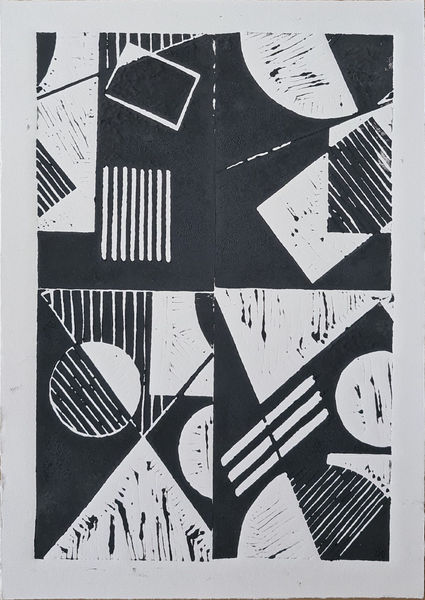AM I GAY ENOUGH
SERIES 2
Statement
I rolled up the carpet in my partner’s bedroom and put it to the side. This carpet had comforted me on many late nights watching TikToks. The walls surrounding me had seen all the trends, heard my laugh and watched me cringe. I laid down sheets of newspaper and set up my materials. A shimmering black block of ink was rolled out on a sheet of perspex. My lino turned black as I rolled ink onto it. My partner, my ‘clean hands’ positioned paper over my lino. I mustered all my strength and used a rolling pin, back and forth over my paper. The prints were blotchy and dull. With sarcasm in her voice, my partner mumbled “Why don’t you just stand on it?”. I threw the rolling pin aside and grabbed fresh socks. Summoning all my body weight, I stepped onto the paper, feeling the indents of the lino under my feet. The paper danced with me for thirty seconds, motioning left and right, up and down; feeling every drop of ink absorbed by my Fabriano. She gently pulled the paper off the linocut and there it was: a perfect print. I thanked lockdown for the ten kilograms I gained.
In the first few days of lockdown, after all of my DIY projects were completed, and the bananas to make banana bread were dwindling; I was bored. I downloaded TikTok. Within the first seventeen minutes of using the app, the algorithm had deduced my sexuality and began feeding me lesbian content. The deeper I went, the more inundated my feed became with lesbian content, subgenre upon subgenre. Hence, my discovery of Lesbian TikTok; featuring all the predictable basics, but as I scrolled down the rabbit hole, I discovered a plethora of niche subgenres. Conforming to the algorithmic loop of production and consumption, creators are put into a subgenre in relation with their appearance and hashtags. The more we engage with a certain subgenre, the more popularity a creator gains, the more they produce. Stuck in an infinite loop. Videos on Lesbian TikTok begin making up a queer archive, one that is subject to the relentless, ever shifting algorithm. Here lies a potential space to reject and destabilise heteronormative behaviours and ideals. TikTok is ‘on’ all the time, we exist in a virtual space where the performance of oneself is constantly being produced and re-produced, consumed and re-consumed.
Imitation lies at the very nature of TikTok. An original video is created; and countless others make use of the sound track, recreating the video almost perfectly. Here, consumable queerness is born; a single constructed and unwavering image of what lesbianism looks and sounds like. As a consequence, a certain set of expectations are set out for lesbians - often made to feel the need to conform to these stereotypes as a means of validating our queerness. The cyclical recreation of these images works to reinforce difference in a homogenised community which is already built on difference, creating and perpetuating divisions. TikTok has a class structure not dissimilar to the world we live in. For many baby gays, the TikTok dream is to gain ‘clout’ which is achieved by amassing likes and followers. I became worried about the lesbian stereotypes present on the app, the need to conform in the interest of becoming a member of the TikTok bourgeoisie. From performing stereotypes to making homophobic videos, anything is justified so long as it initiates interaction. But since TikTok is more than just a platform that receives and communicates meaning, some stereotypes are awarded for their ability to generate popularity on the app.
This series mimics certain attributes of TikTok as well as the culture it has created through the use of repeated videos; images out of frame mimicking the amateur nature of video creation on the app, the layering of two sounds played on top of one another; the finger swiping across the glass, connecting subgenres as we scroll through these videos on our devices; mimicry of font and logo colours, colloquial language and emoticons on linocuts.
The video artwork negotiates the breaking down and disruption of lesbian stereotypes running rampant on the app, commenting on the scripted versus real life, while mapping a personal interpretation of the algorithm. The simple form of the 2 dimensional layered algorithmic map contrasts the complexity of the algorithm that TikTok prides itself on. When one begins to map out this ‘complex’ algorithm, trends and relationships become clearer. Linocuts work as visualisations of the algorithm, and the reorganising of the same visualisation begins to disrupt the algorithm, reconstituting, reimagining and reshaping it. The decontextualisation of videos impedes on the stereotypes in circulation, allowing for a clearer and more critical reading of performances where the TikTok culture begins to crumble. The work criticises the algorithm as a cultural means of production by isolating popular phrases and concepts, simplifying them into print.
The insertion of my body acts as the commentator moving through the various sides of Lesbian TikTok through voice and performance of the body, capturing the performativity of sexuality on the app, while critically investigating how, where and why these subgenres meet. The laborious tasks of the body contrasts the nature of a digital space. The remnants of the map are printed, creating a permanence in a temporary and ever shifting space. The residue remains, mimicking song lyrics stuck in my head when the app is finally closed.
AM I GAY ENOUGH
SERIES 2
Untitled 1
2020
39 minutes 24 seconds
Video Artwork
PRINTS

DUET WITH ME
Do you have rights as a lesbian in your country? Do you have privileges? Can you hold your partner’s hand in public? Can you disclose your sexuality on TikTok TikTok TikTok? Can you listen to girl in red?














